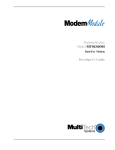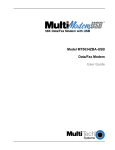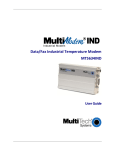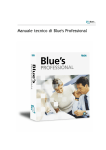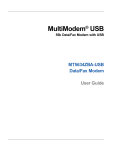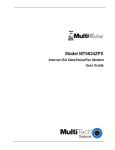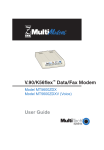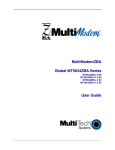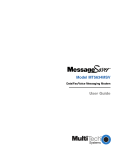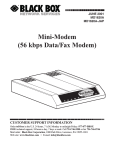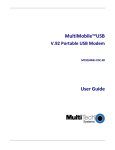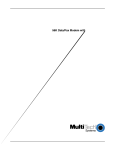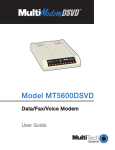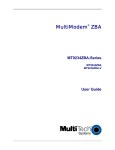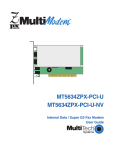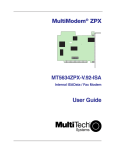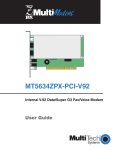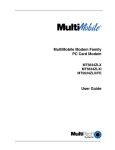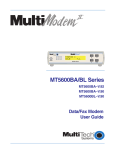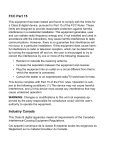Download MiniModem USB
Transcript
JANUARY 1999 MD1625A MiniModem USB TD RD CD OH R TR PW CUSTOMER SUPPORT INFORMATION Order toll-free in the U.S.: Call 877-877-BBOX (outside U.S. call 724-746-5500) FREE technical support 24 hours a day, 7 days a week: Call 724-746-5500 or fax 724-746-0746 Mailing address: Black Box Corporation, 1000 Park Drive, Lawrence, PA 15055-1018 Web site: www.blackbox.com • E-mail: [email protected] MINIMODEM USB FEDERAL COMMUNICATIONS COMMISSION AND INDUSTRY CANADA RADIO FREQUENCY INTERFERENCE STATEMENTS This equipment generates, uses, and can radiate radio frequency energy and if not installed and used properly, that is, in strict accordance with the manufacturer’s instructions, may cause interference to radio communication. It has been tested and found to comply with the limits for a Class A computing device in accordance with the specifications in Subpart J of Part 15 of FCC rules, which are designed to provide reasonable protection against such interference when the equipment is operated in a commercial environment. Operation of this equipment in a residential area is likely to cause interference, in which case the user at his own expense will be required to take whatever measures may be necessary to correct the interference. Changes or modifications not expressly approved by the party responsible for compliance could void the user’s authority to operate the equipment. This digital apparatus does not exceed the Class A limits for radio noise emission from digital apparatus set out in the Radio Interference Regulation of Industry Canada. Le présent appareil numérique n’émet pas de bruits radioélectriques dépassant les limites applicables aux appareils numériques de classe A prescrites dans le Règlement sur le brouillage radioélectrique publié par Industrie Canada. 1 MINIMODEM USB FCC REQUIREMENTS FOR TELEPHONE-LINE EQUIPMENT 1. The Federal Communications Commission (FCC) has established rules which permit this device to be directly connected to the telephone network with standardized jacks. This equipment should not be used on party lines or coin lines. 2. If this device is malfunctioning, it may also be causing harm to the telephone network; this device should be disconnected until the source of the problem can be determined and until the repair has been made. If this is not done, the telephone company may temporarily disconnect service. 3. If you have problems with your telephone equipment after installing this device, disconnect this device from the line to see if it is causing the problem If it is, contact your supplier or an authorized agent. 4. The telephone company may make changes in its technical operations and procedures. If any such changes affect the compatibility or use of this device, the telephone company is required to give adequate notice of the changes. 2 MINIMODEM USB 5. If the telephone company requests information on what equipment is connected to their lines, inform them of: a. The telephone number that this unit is connected to. b. The ringer equivalence number. c. The USOC jack required: RJ-11C. d. The FCC registration number. Items (b) and (d) can be found on the unit’s FCC label. The ringer equivalence number (REN) is used to determine how many devices can be connected to your telephone line. In most areas, the sum of the RENs of all devices on any one line should not exceed five (5.0). If too many devices are attached, they may not ring properly. 6. In the event of an equipment malfunction, all repairs should be performed by your supplier or an authorized agent. It is the responsibility of users requiring service to report the need for service to the supplier or to an authorized agent. 3 MINIMODEM USB NORMAS OFICIALES MEXICANAS (NOM) ELECTRICAL SAFETY STATEMENT INSTRUCCIONES DE SEGURIDAD 1. Todas las instrucciones de seguridad y operación deberán ser leídas antes de que el aparato eléctrico sea operado. 2. Las instrucciones de seguridad y operación deberán ser guardadas para referencia futura. 3. Todas las advertencias en el aparato eléctrico y en sus instrucciones de operación deben ser respetadas. 4. Todas las instrucciones de operación y uso deben ser seguidas. 5. El aparato eléctrico no deberá ser usado cerca del agua—por ejemplo, cerca de la tina de baño, lavabo, sótano mojado o cerca de una alberca, etc.. 6. El aparato eléctrico debe ser usado únicamente con carritos o pedestales que sean recomendados por el fabricante. 7. El aparato eléctrico debe ser montado a la pared o al techo sólo como sea recomendado por el fabricante. 8. Servicio—El usuario no debe intentar dar servicio al equipo eléctrico más allá a lo descrito en las instrucciones de operación. Todo otro servicio deberá ser referido a personal de servicio calificado. 9. El aparato eléctrico debe ser situado de tal manera que su posición no interfiera su uso. La colocación del aparato eléctrico sobre una cama, sofá, alfombra o superficie similar puede bloquea la ventilación, no se debe colocar en libreros o gabinetes que impidan el flujo de aire por los orificios de ventilación. 4 MINIMODEM USB 10. El equipo eléctrico deber ser situado fuera del alcance de fuentes de calor como radiadores, registros de calor, estufas u otros aparatos (incluyendo amplificadores) que producen calor. 11. El aparato eléctrico deberá ser connectado a una fuente de poder sólo del tipo descrito en el instructivo de operación, o como se indique en el aparato. 12. Precaución debe ser tomada de tal manera que la tierra fisica y la polarización del equipo no sea eliminada. 13. Los cables de la fuente de poder deben ser guiados de tal manera que no sean pisados ni pellizcados por objetos colocados sobre o contra ellos, poniendo particular atención a los contactos y receptáculos donde salen del aparato. 14. El equipo eléctrico debe ser limpiado únicamente de acuerdo a las recomendaciones del fabricante. 15. En caso de existir, una antena externa deberá ser localizada lejos de las lineas de energia. 16. El cable de corriente deberá ser desconectado del cuando el equipo no sea usado por un largo periodo de tiempo. 17. Cuidado debe ser tomado de tal manera que objectos liquidos no sean derramados sobre la cubierta u orificios de ventilación. 18. Servicio por personal calificado deberá ser provisto cuando: A: El cable de poder o el contacto ha sido dañado; u B: Objectos han caído o líquido ha sido derramado dentro del aparato; o C: El aparato ha sido expuesto a la lluvia; o D: El aparato parece no operar normalmente o muestra un cambio en su desempeño; o E: El aparato ha sido tirado o su cubierta ha sido dañada. 5 MINIMODEM USB TRADEMARKS Adobe, Acrobat, and Acrobat Reader are trademarks of Adobe Systems Incorporated. IBM is a trademark of International Business Machines Corporation. MNP and Microcom Network Protocol are trademarks of Microcom, Inc. K56flex is a registered trademark of Rockwell International Corporation and Lucent Technologies Corporation. Microsoft, Windows, Windows 95, and Windows NT are either registered trademarks or trademarks of Microsoft Corporation in the United States and other countries. NOTICE Though these modems are capable of 56-kbps download performance, line impairments, public telephone infrastructure and other external technological factors currently prevent maximum 56kbps connections. Any trademarks mentioned in this manual are acknowledged to be the property of the trademark owners. 6 MINIMODEM USB CONTENTS 1. Specifications. . . . . . . . . . . . . . . . . . . . . . . . . . . . . . . 11 2. Introduction . . . . . . . . . . . . . . . . . . . . . . . . . . . . . . . 16 2.1 Description . . . . . . . . . . . . . . . . . . . . . . . . . . . . . 16 2.2 Universal Serial Bus (USB) . . . . . . . . . . . . . . . . 17 2.3 What the Package Includes . . . . . . . . . . . . . . . . 17 3. Quick Start. . . . . . . . . . . . . . . . . . . . . . . . . . . . . . . . . 19 3.1 Introduction . . . . . . . . . . . . . . . . . . . . . . . . . . . . 19 3.2 What You Will Need . . . . . . . . . . . . . . . . . . . . . . 19 3.2.1 We Supply. . . . . . . . . . . . . . . . . . . . . . . . . . 19 3.2.2 You Supply . . . . . . . . . . . . . . . . . . . . . . . . . 20 3.3 Safety Warnings . . . . . . . . . . . . . . . . . . . . . . . . . . 20 3.4 Step 1: Assemble the Modem . . . . . . . . . . . . . . . 21 3.5 Step 2: Connect the Modem to Your System . . 22 3.5.1 USB Connection . . . . . . . . . . . . . . . . . . . . 23 3.5.2 Line Connection . . . . . . . . . . . . . . . . . . . . 23 3.5.3 Phone Connection. . . . . . . . . . . . . . . . . . . 23 3.6 Step 3: Install the Modem in Windows . . . . . . . 24 3.6.1 Adding the Modem to Windows 98 . . . . . 24 3.6.2 Installation in Windows 95 . . . . . . . . . . . . 25 3.6.3 Removing Your Old Modem from Windows 95/98 . . . . . . . . . . . . . . . . . . . . . 27 3.7 Step 4: Send Data . . . . . . . . . . . . . . . . . . . . . . . . 28 7 MINIMODEM USB 3.8 Step 5: Send a Fax . . . . . . . . . . . . . . . . . . . . . . . . 28 3.9 References . . . . . . . . . . . . . . . . . . . . . . . . . . . . . . 28 4. Features . . . . . . . . . . . . . . . . . . . . . . . . . . . . . . . . . . 29 4.1 What Can You Do With Your Modem? . . . . . . . 29 4.2 Features . . . . . . . . . . . . . . . . . . . . . . . . . . . . . . . . 29 4.2.1 Data. . . . . . . . . . . . . . . . . . . . . . . . . . . . . . . 30 4.2.2 Fax. . . . . . . . . . . . . . . . . . . . . . . . . . . . . . . . 31 4.3 Connections. . . . . . . . . . . . . . . . . . . . . . . . . . . . . 33 4.3.1 Connecting to the Computer (“USB”) . . 33 4.3.2 Connecting to the Telephone Line (“LINE”) . . . . . . . . . . . . . . . . . . . . . . . . . . 34 4.3.3 Connecting to a Telephone Set (“PHONE”) . . . . . . . . . . . . . . . . . . . . . . . . 34 4.3.4 Surge Protectors and Lightning . . . . . . . . 35 4.4 Front Panel . . . . . . . . . . . . . . . . . . . . . . . . . . . . . 35 5. AT Commands, S-Registers, and Result Codes. . . . 37 5.1 AT Commands. . . . . . . . . . . . . . . . . . . . . . . . . . . 37 5.2 AT Command Summary. . . . . . . . . . . . . . . . . . . 40 5.3 S-Registers . . . . . . . . . . . . . . . . . . . . . . . . . . . . . . 68 5.4 Result Codes . . . . . . . . . . . . . . . . . . . . . . . . . . . . 73 6. Remote Configuration . . . . . . . . . . . . . . . . . . . . . . . 77 6.1 Introduction . . . . . . . . . . . . . . . . . . . . . . . . . . . . 77 6.2 Basic Procedure. . . . . . . . . . . . . . . . . . . . . . . . . . 77 8 MINIMODEM USB 6.3 Setup . . . . . . . . . . . . . . . . . . . . . . . . . . . . . . . . . . 78 6.3.1 Changing the Setup Password . . . . . . . . . 78 6.3.2 Changing the Remote Escape Character . . . . . . . . . . . . . . . . . . . . . . . . . . 79 7. Troubleshooting . . . . . . . . . . . . . . . . . . . . . . . . . . . . 81 7.1 Introduction . . . . . . . . . . . . . . . . . . . . . . . . . . . . 81 7.2 None of the Indicators Light . . . . . . . . . . . . . . . 82 7.3 The Modem Does Not Respond to Commands . . . . . . . . . . . . . . . . . . . . . . . . . . . . . 82 7.4 The Modem Dials But Cannot Connect . . . . . . 83 7.5 The Modem Disconnects While Online . . . . . . 87 7.6 The Modem Cannot Connect When Answering . . . . . . . . . . . . . . . . . . . . . . . . . . . . . . 88 7.7 The Modem Doesn’t Work with Caller ID . . . . 88 7.8 Fax and Data Software Can’t Run at the Same Time. . . . . . . . . . . . . . . . . . . . . . . . . . . . . . 89 Appendix A: Regulatory Compliance . . . . . . . . . . . . . 90 A.1 FCC Certification . . . . . . . . . . . . . . . . . . . . . . . . 90 A.2 Canadian Limitations Notice. . . . . . . . . . . . . . . 90 A.3 Compliance with BABT Requirements. . . . . . . 92 A.4 European Low Voltage Directive. . . . . . . . . . . . 93 A.5 EMC, Safety, and Terminal Directive Compliance . . . . . . . . . . . . . . . . . . . . . . . . . . . . . 94 9 MINIMODEM USB A.6 Australian Modem Warning Notice . . . . . . . . . 95 A.7 New Zealand Telecom Warning Notice . . . . . . 97 Appendix B: Loopback Tests . . . . . . . . . . . . . . . . . . . . 98 B.1 Introduction . . . . . . . . . . . . . . . . . . . . . . . . . . . . 98 B.2 Local Analog Loopback Test (V.54 Loop 3) . . 99 B.3 Remote Digital Loopback Test (V.54 Loop 2) . 101 B.4 Local Digital Loopback Test (V.54 Loop 2) . . . 104 Index.............. . . . . . . . . . . . . . . . . . . . . . . . . . . . . . . . . 107 10 MINIMODEM USB 1. Specifications Client-to-Server Data Rates—V.90 or K56flex speeds (up to about 53 kbps) when accessing an ISP-type K56flex server (actual speed depends on server capabilities and line conditions) Client-to-Client Data Rates—33,600, 31,200, 28,800, 26,400, 24,000, 21,600, 19,200, 16,800, 14,400, 12,000, 9600, 7200, 4800, 2400, 1200, 0–300 bps Fax Data Rates—14,400, 9600, 7200, 4800, 2400, 300 bps Data Format—Serial, binary, asynchronous Modem Capability—K56flex; ITU-T V.90, V.34 enhanced, V.34, V.32terbo, V.32bis, V.32, V.22bis, V.22; Bell 212A and 103/113; ITU-T V.29, V.42, V.42bis; ITU-T V.21 and V.23 in international versions Fax Capability—ITU-T Group 3, Class 1 and 2, T.4, T.30, V.21, V.27ter, V.29, V.17, and TIA/EIA TR29.2 Error Correction—ITU-T V.42 (LAP-M or MNP 3-4) 11 MINIMODEM USB Data Compression—ITU-T V.42bis (4:1 throughput), MNP 5 (2:1 throughput) Flow Control—XON/XOFF (software), RTS/CTS (hardware) Intelligent Features—Plug and play; fully AT command compatible; autodial, redial, repeat dial; pulse or tone dial; dial pauses; auto answer; caller ID; EIA extended automode; adaptive line probing; automatic symbol and carrier frequency during start-up, retrain, and rate regeneration; DTMF detection; call status display, auto-parity and data rate selections; keyboard-controlled modem options; non-volatile memory; on-screen displays for modem option parameters; command lines of up to 40 characters each; help menus; remote configuration Command Buffer—40 characters Data Modulation—FSK at 300 bps, PSK at 1200 bps, QAM at 2400, 4800, and 9600 bps (non-trellis), QAM with trellis-coded modulation (TCM) at 9600, 12,000, 14,400, 16,800, 19,200, 21,600, 24,000, 26,400, 28,800, 31,200, 33,600, and 56,000 bps 12 MINIMODEM USB Fax Modulation—V.21 CH2 FSK at 300 bps (half duplex); V.27ter DPSK at 4800 and 2400 bps; V.29 QAM at 9600 and 7200 bps; V.17TCM at 14,400, 12,000, 9600, and 7200 bps Carrier Frequencies— ITU-T V.34: 1600, 1646, 1680, 1800, 1829, 1867, 1920, 1959, 2000 Hz AT&T V.32 terbo/ITU-T V.32 bis/V.32: 1800 Hz V.22bis/V.22 or Bell 212A Standard (2400 and 1200 bps): Transmit originate: 1200 Hz; Transmit answer: 2400 Hz; Receive originate: 2400 Hz; Receive answer: 1200 Hz ITU-T V.23 (1200 bps): Transmit originate: 390 Hz mark, 450 Hz space; Receive originate: 1300 Hz mark, 2100 Hz space; Transmit answer: 1300 Hz mark, 2100 Hz space; Receive answer: 390 Hz mark, 450 Hz space ITU-T V.21 (0–300 bps): Transmit originate: 980 Hz mark, 1180 Hz space; Receive originate: 1650 Hz mark, 1850 Hz space; Transmit answer: 1650 Hz mark, 1850 Hz space; Receive answer: 980 Hz mark, 1180 Hz space 13 MINIMODEM USB Bell 103/113 (0–300 bps): Transmit originate: 1270 Hz mark, 1070 Hz space; Receive originate: 2225 Hz mark, 2025 Hz space; Transmit answer: 2225 Hz mark, 2025 Hz space; Receive answer: 1270 Hz mark, 1070 Hz space Fax Carrier Frequencies—V.21 Ch2 (half duplex): 1650 Hz mark, 1850 Hz space for transmit originate; 1650 Hz mark, 1850 Hz space for transmit answer; V.27ter: 1800 Hz originate/answer; V.29 QAM: 1800 Hz originate/answer; V.17 TCM: 1800 Hz originate/answer Transmit Level— -11 dBm (dial-up) Frequency Stability— ±0.01% Receiver Sensitivity— -43 dBm under worst-case conditions AGC Dynamic Range—43 dB Connectors—(1) USB connector; (2) RJ-11 phone jacks Cables—(1) 7-ft. RJ-11 phone cable; (1) 4-ft. USB cable 14 MINIMODEM USB NOTE To reduce interference, make sure that all cables connected to the computer are shielded. Diagnostics—Power-on self-test, local analog loop, local digital loop, remote digital loop Indicators—LEDs for Transmit Data, Receive Data, Carrier Detect, Off Hook, Terminal Ready, Power Operating Temperature—32 to 120 °F (0 to 50 °C) Humidity—20 to 90% noncondensing Size—1.2"H x 4.3"W x 5.8"D (2.9 x 10.8 x 14.8 cm) Weight—0.5 lb. (0.2 kg) 15 MINIMODEM USB 2. Introduction 2.1 Description The MiniModem USB incorporates V.90 technology, which enables Internet connections at data rates up to 56 kbps over standard telephone lines. (Although V.90 technology is capable of downloads of up to 56 kbps, FCC regulations currently restrict ISP modems to downloads of 53 kbps.) V.90 technology can send data downstream from the Internet to your computer at these speeds because data on the telephone network typically is converted from digital to analog only once before it reaches your modem. Upstream transmissions, and transmissions between client modems, are limited to data rates of 33.6 kbps, as are downstream transmissions that are converted more than once on the telephone network. The MiniModem USB is a full-duplex intelligent modem with V.42 error correction, V.42bis data compression, and V.17 (14,400 bps), Class 1 and 2, Group 3 fax capabilities. 16 MINIMODEM USB 2.2 Universal Serial Bus (USB) Universal Serial Bus (USB), defined by a consortium of industry leaders, permits connection of multiple lowspeed and medium speed computer peripheral devices such as telephones, modems, printers, keyboards, mice, and scanners, all from a single personal computer port. The specification, based on an open architecture, is quickly becoming a standard feature in new desktop and notebook computers. 2.3 What the Package Includes Make sure that your package contains the following components. If anything is missing or damaged, please contact Black Box immediately at 724-746-5500. • (1) MiniModem USB • (1) set of four plastic feet • (2) sets of Velcro fasteners • (1) modular telephone cable • (1) USB cable 17 MINIMODEM USB • (1) installation diskette • This user’s manual • Trio data, fax, and voice software 18 MINIMODEM USB 3. Quick Start 3.1 Introduction We know that you are eager to get your MiniModem up and running, so we’ll skip the features for now, and show you step-by-step how to set it up, check it out, and make your first calls. 3.2 What You Will Need Before starting, please make sure you have everything you need: 3.2.1 WE SUPPLY • (1) USB data/fax modem • (1) set of four plastic feet • (2) sets of hook-and-loop fasteners • (1) modular telephone cable • (1) USB cable • Trio communications software 19 MINIMODEM USB • This user’s manual • (1) installation disk 3.2.2 YOU SUPPLY • A computer with an unused USB port • A nearby telephone line jack If you are new to computers, see Chapter 4 for more information about the required equipment. 3.3 Safety Warnings • Never install telephone wiring during a lightning storm. • Never install a telephone jack in a wet location unless the jack is specifically designed for wet locations. • Never touch uninsulated telephone wires or terminals unless the telephone line has been disconnected at the network interface. • Use caution when installing or modifying telephone lines. 20 MINIMODEM USB • Avoid using a telephone (other than a cordless type) during an electrical storm; there may be a remote risk of electrical shock from lightning. • Do not use a telephone in the vicinity of a gas leak. 3.4 Step 1: Assemble the Modem The only assembly required is to mount the feet on the bottom of the modem. Simply peel the four self-adhesive plastic feet off the backing strip and press them into the recesses on the bottom of the modem. Alternately, or additionally, you can use the included self-adhesive hook-and-loop patches to mount the modem on a vertical surface or to keep it from being dislodged on a horizontal surface. If you use the hook-and-loop patches, we recommend that you mount them where they will not obscure the labels or screws on the bottom of the modem. 21 MINIMODEM USB Figure 3-1. Mounting the feet. 3.5 Step 2: Connect the Modem to Your System Placing the modem in a convenient location, connect it to your computer’s USB port, to the telephone line, and, optionally, to your telephone. USB PHONE LINE Figure 3-2. Modem connections. 22 MINIMODEM USB 3.5.1 USB CONNECTION Plug one end of the USB cable into the USB connector on the modem, and the other end into a USB port connector on your computer. 3.5.2 LINE CONNECTION Plug one end of the phone cable into the modem’s LINE jack, and the other end into a phone line wall jack. NOTE The LINE jack is not interchangeable with the PHONE jack. Do not plug the phone into the LINE jack or the line cable into the PHONE jack. The Federal Communications Commission (FCC) and Industry Canada impose certain restrictions on equipment connected to public telephone systems. See Appendix A for more information. 3.5.3 PHONE CONNECTION For voice-only calls, you can optionally plug a telephone into the modem’s PHONE jack. 23 MINIMODEM USB 3.6 Step 3: Install the Modem in Windows If you are using Windows 98 or 95, you must install the modem in the operating system. (If you are using another operating system, you can skip this step.) 3.6.1 ADDING THE MODEM TO WINDOWS 98 1. Power up your Windows 98 system. 2. If you have not already done so, connect one end of your USB cable to a USB connector on your PC, and connect the other end to the USB connector on your modem. The Power LED on your modem will light. 3. Windows will detect that the new modem is present and launch the Add New Hardware Wizard. 4. Place the Installation diskette provided with your modem into your floppy drive and click Next to proceed with the installation. 5. Verify that the “Search for the best driver for your device. (Recommended)” option is selected and click Next. 24 MINIMODEM USB 6. Verify that the “Floppy disk drives” option is selected and click Next. 7. Windows will select the proper driver from the installation disk and will display the information for verification. Click Next to install the selected driver. 8. A message will appear when Windows finishes installing the driver. Click Finish to complete the installation and exit the wizard. The TR LED on your modem will light when the installation is complete. 3.6.2 INSTALLATION IN WINDOWS 95 Only certain versions of Windows 95 support USB peripherals. If your computer came with a USB port, your version of Windows 95 probably supports UCB. If you are unsure if your Windows 95 system supports USB, a free USB evaluation utility is available from the Shopping Bag page at http://www.usb.org. Just download the utility (287K) and run the .exe application. It will determine if you have USB support. If you would like to install your MiniModem in Windows 95, perform the following steps. 25 MINIMODEM USB Installing in Windows 95 1. Insert the Setup disk provided with your modem into your floppy drive. 2. If you have not already done so, connect one end of your USB cable to a USB connector on your PC, and connect the other end to the USB connector on your modem. The Power LED on your modem will light. 3. Windows will detect that the new modem is present and launch the Update Device Driver Wizard. Click Next to proceed with the installation. 4. Windows searches for the driver on A:\ and, when identified, will display the driver name for verification. Click Finish to install the driver. 5. Windows prompts you to insert a diskette. You have already inserted the diskette, so click OK to continue. The Copy Files dialog is displayed. In the Copy files from field, choose A:\ from the drop-down list and click OK. 6. When the driver is installed, a completion message will appear, the TR LED on your modem will light, 26 MINIMODEM USB and the wizard will exit. Your installation is now complete. 3.6.3 REMOVING YOUR OLD MODEM FROM WINDOWS 95/98 When your new modem replaces another modem, the old modem installation remains in Windows 95/98 after you install the new modem, and the old modem is still selected in HyperTerminal and other Windows 95/98 applications. Although you can change the application connection descriptions one at a time, it’s easier to force Windows applications to use the new modem by removing the old modem from Windows. Follow these steps: 1. Click Start | Settings | Control Panel. 2. Double-click the Modems icon to open the Modems Properties sheet. 3. In the list box, select the old modem. 4. Click Remove, then click Close. 5. The next time you dial a HyperTerminal connection, it will select your new modem and ask you to confirm the selection. 27 MINIMODEM USB 3.7 Step 4: Send Data Call Black Box Technical Support at 724-746-5500 for instructions on how to test the modem’s data functions. 3.8 Step 5: Send a Fax Call Black Box Technical Support at 724-746-5500 for instructions on how to test the modem’s fax functions. 3.9 References The World-Wide Web is an excellent source of information about modems in general and modem installation, configuration, and troubleshooting. The following Web sites are good places to start: • Costmo’s Other Resources Page: http://modems.rosenet.net/or/ • Curt’s High Speed Modem Page: http://elaine.teleport.com/~curt/modems.html • Data Communications FAQ: http://www.best.com/~malch/comfaq.html 28 MINIMODEM USB 4. Features 4.1 What Can You Do with Your Modem? You can use your MiniModem to access the Internet or commercial on-line information services such as CompuServe, America Online, Genie, and Prodigy. You can also make direct links with colleagues with modems, to banks, and to service bureaus. You can telecommute with your fax modem—work at home while communicating with the office by modem or fax. And you can use your modem to exchange faxes with any fax machine in the world, enabling you to communicate quickly with businesses and organizations that do not have direct modem communications. 4.2 Features • Complies with major ITU-T, TIA, and EIA international standards to ensure compatibility with other modems. • Caller ID capability can identify a caller’s phone number (available only on U.S. products, if you subscribe to Caller ID service from your phone company). 29 MINIMODEM USB 4.2.1 DATA • Supports the V.90 standard for data transmission speeds up to 56 kbps while maintaining compatibility with lower-speed modems. (Actual speeds are currently limited to 53 kbps in the U.S.) • Supports the enhanced ITU-T V.34 standard, with data transmission speeds to 33.6 kbps. • Supports asynchronous data rates at 56, 33.6, 31.2, 28.8, 26.4, 24, 21.6, 19.2, 16.8, 14.4, and 12 kbps, and 9600, 4800, 2400, 1200, and 300 bps. • Supports automatic fallback to slower speeds in noisy line conditions, and fall-forward to faster speeds as connections improve. • ITU-T V.42 LAP-M and MNP Class 3 and 4 error correction. • ITU-T V.42bis (4-to-1) and MNP 5 (2-to-1) data compression. • Automatically disables data compression when transferring already-compressed files. • Autodial, redial, pulse (rotary) and touch-tone dial. 30 MINIMODEM USB • Dial tone and busy signal detection for reliable call-progress reporting. • Compatible with the standard AT command set used by most communication programs. 4.2.2 FAX • Supports V.17, Group 3 fax communication standards, allowing it to communicate with other fax modems as well as with fax machines. • Responds to EIA/TIA Class 1 and 2 fax commands, enabling it to exchange editable and encrypted faxes with Windows 95 computers. • Sends and receives faxes from your computer at 14,400, 9600, 7200, 4800, 2400, or 300 bps. 4.2.3 REQUIRED EQUIPMENT In addition to the contents of your modem package, you need equipment. Computer Your modem can only be connected to a computer with a USB port. 31 MINIMODEM USB Telephone Line You must have a telephone line with a jack (connector) that accepts the cable that comes with the modem. If you do not have a telephone jack near your computer, install one before proceeding. Do-it-yourself telephone extension kits and accessories are available wherever telephones are sold. You may also hire an independent contractor or your local telephone company to install an extension. If you want a separate line for your modem, you must contact your telephone company. Communications Software To operate your modem, you must have datacommunications and fax software (included with the modem). Data-communications software simplifies control of the modem by guiding you through the process of selecting your serial port, your port speed, and other variables, and then storing your settings, including frequently called phone numbers, so they can be recalled with the stroke of a key or the click of a mouse. Data communications software must be set up, or configured, before you can use it. 32 MINIMODEM USB 4.3 Connections To use your modem, you must connect it to your computer (“USB”), to a telephone line (“LINE”), and optionally to a telephone set (“PHONE”). Figure 4-1. USB and communications connectors. 4.3.1 CONNECTING TO THE COMPUTER (“USB”) Using a USB cable, connect the USB connector on the modem to a USB connector on the back of your computer. 33 MINIMODEM USB 4.3.2 CONNECTING TO THE TELEPHONE LINE (“LINE”) Plug one end of the cable provided with the modem into the telephone jack in your home or office. Plug the other end into the LINE jack on the modem. NOTE The LINE jack is not interchangeable with the PHONE jack. Do not plug the telephone into the LINE jack or the line cable into the PHONE jack. NOTE The Federal Communications Commission (FCC), Industry Canada, and other regulatory agencies impose certain restrictions on equipment connected to public telephone systems. See Appendix A for more information. 4.3.3 CONNECTING TO A TELEPHONE SET (“PHONE”) If you wish to connect a telephone to the same line as the modem, you can plug it into the modem’s PHONE jack. This connector is provided as a convenience; you can also connect your telephone to a duplex jack inserted into your wall jack. NOTE The PHONE jack is not interchangeable with the LINE jack; do not plug the telephone into the LINE jack or the line cable into the PHONE jack. 34 MINIMODEM USB 4.3.4 SURGE PROTECTORS AND LIGHTNING Your modem has self-resetting lightning protection to protect it from electrical spikes on the telephone line. During an electrical storm, your safest course is to unplug your computer equipment from both the power outlet and the telephone line. 4.4 Front Panel TD RD CD OH TR PWR Figure 4-2. Front panel. The MiniModem has six LED indicators on the front panel that indicate status, configuration, and activity: • TD: Transmit Data. The TD LED flashes when the modem is transmitting data to another modem. 35 MINIMODEM USB • RD: Receive Data. The RD LED flashes when the modem is receiving data from another modem. • CD: Carrier Detect. The CD LED lights when the modem detects a valid carrier signal from another modem. It is on when the modem is communicating with the other modem and off when the link is broken. • OH: Off-Hook. The OH LED lights when the modem is off-hook, which occurs when the modem is dialing, online, or answering a call. The LED flashes when the modem pulse-dials. • TR: Terminal Ready. The TR LED lights when Windows detects and initializes the modem. • PWR: Power. The PWR led lights when the system is applying power to the modem. 36 MINIMODEM USB 5. AT Commands, S-Registers, and Result Codes Most users never need to know the modem’s special command language. Windows or your communications software will send the commands for you; you just set up the configuration in the Windows dialog box. Advanced users, however, might find it more efficient to talk to the modem directly. If you want to know about the modem’s internal command language, read this chapter. 5.1 AT Commands AT commands are used to control the operation of your modem. They are so called because each command must be preceded by the characters AT to get the ATtention of the modem. AT commands can be issued only when the modem is in command mode whenever it is not connected to another modem. The modem is in command mode whenever it is not connected to another modem. The modem is in data mode whenever it is connected to another modem and ready to exchange data. Online 37 MINIMODEM USB command mode is a temporary state in which you can issue commands to the modem while connected to another modem. To put the modem into online command mode from data mode, you must issue an escape sequence (+++) followed immediately by the AT characters and the command—for example, +++ATH to hang up the modem. To return to data mode from online command mode, you must issue the command ATO. To send AT commands to the modem, you must use a communications program, such as HyperTerminal in Windows 95, 98, and NT 4.0, or the communications program included with your modem. You can issue commands to the modem either directly, by typing them in the terminal window of the communications program, or indirectly, by configuring the operating system or communications program to send the command automatically. The format for entering a command is ATXn, where X is the command and n is the specific value for the command, sometimes called the command parameter. The value is always a number. If the value is zero, you can omit it from the command; thus, AT&W is 38 MINIMODEM USB equivalent to AT&W0. Most commands have a default value, which is the value that is set at the factory. The default values are shown in the “AT Command Summary,” which begins on the next page. You must press ENTER to send the command to the modem. Any time the modem receives a command, it sends a response known as a result code. The most common result codes are OK, ERROR, and the CONNECT messages that the modem sends to the computer when it is connecting to another modem. For a table of valid result codes, see Section 5.4. You can issue several commands in one line, in what is called a string. The command string begins with AT and ends when you press ENTER. Spaces to separate the commands are optional; they are ignored by the command interpreter. The most familiar command string is the initialization string, which is used to configure the modem when it is turned on or reset, or when your communications software calls another modem. 39 MINIMODEM USB 5.2 AT Command Summary Command: Values: Description: Attention Code n/a The attention code precedes all command lines except A/ and escape sequences. Command: Values: Description: ENTER Key n/a Press the (Return) key to execute most commands. Command: Values: Description: A Answer n/a Answer call before final ring. Command: Values: Description: A/ Repeat Last Command n/a Repeat the last command string. Do not precede this command with AT. Do not press Enter to execute. 40 AT MINIMODEM USB Command: Values: Default: Description: Command: Values: Default: Description: Bn Communication Standard Setting n = 0–3, 15, 16 1 and 16 B0 Select ITU-T B1 Select Bell 212A when modem is at 1200 bps. B2 Deselect V.23 reverse channel (same as B3). B3 Deselect V.23 reverse channel (same as B2). B15 Select V.21 when the modem is at 300 bps. B16 Select Bell 103J when the modem is at 300 bps. Cn n=1 1 C0 C1 Carrier Control Transmit carrier always off. (Not supported.) Normal transmit carrier switching (included for backward compatibility with some software). 41 MINIMODEM USB Command: Values: Default: Description: 42 Ds Dial s = dial string (phone number and dial modifiers) none Dial telephone number s, where s may up to 40 characters long and include the 0–9, *, #, A, B, C, and D characters, and the L, P, T, V, W, S, comma (,), semicolon (;), !, @, ^ and $ dial string modifiers. L Redial last number. (Must be placed immediately after ATD.) P Pulse-dial following numbers in command. T Tone-dial following numbers in command (default). V Switch to speakerphone mode and dial the following number. Use ATH command to hang up. W Wait for a new dial tone before continuing to dial. (X2, X4, X5, X6, or X7 must be selected.) MINIMODEM USB , ; ! @ ^ $ Pause during dialing for time set in register S8. Return to command mode after dialing. (Place at end of dial string.) Hook flash. Causes the modem to go on-hook for one-half second, then offhook again. Wait for quiet answer. Causes modem to wait for a ringback, then 5 seconds of silence, before processing next part of command. If silence is not detected, the modem returns a NO ANSWER code. Disable data calling tone transmission. Detect AT&T calling-card “bong” tone. The character should follow the phone number and precede the user’s calling-card number: ATDT1028807245551212$123 456789 43 MINIMODEM USB Command: DS=y Values: Default: Description: n = 0–3 none Dial a number previously stored in directory number y by the &Zy=x command. Example: ATDS=3 En Echo Command Mode Characters n = 0 or 1 1 E0 Do not echo keyboard input to the terminal. E1 Do echo keyboard input to the terminal. Command: Values: Default: Description: Command: Values: Default: Description: Fn n=1 1 F0 F1 44 Dial Stored Telephone Number Echo Online Data Characters Enable online data character echo. (Not supported.) Disable online data character echo (included for backward compatibility with some software). MINIMODEM USB Command: Values: Default: Description: Command: Values: Default: Description: Hn Hook Control n = 0 or 1 0 H0 Go on-hook (hang up). H1 Go off-hook (make the phone line busy). In Information Request n = 0–5, 9, 11 None I0 Display default speed and controller firmware version. I1 Calculate and display ROM checksum (for example, 12AB). I2 Check ROM and verify the checksum, displaying OK or ERROR. I3 Display default speed and controller firmware version. I4 Display firmware version for data pump (for example, 94). I5 Display the board ID: software version, hardware version, and country ID. I9 Display the country code (for example, NA Ver. 1). 45 MINIMODEM USB I11 Display diagnostic information for the last modem connection, such as DSP and firmware version, link type, line speed, serial speed, type of error correction/data compression, number of past retrains, etc. Command: Values: Default: Description: Ln Monitor Speaker Volume n = 0, 1, 2, or 3 2 L0 Select low volume. L1 Select low volume. L2 Select medium volume. L3 Select high volume. Command: Values: Default: Description: Mn Monitor Speaker Mode n = 0, 1, 2, or 3 1 M0 Speaker always off. M1 Speaker on until carrier signal detected. M2 Speaker always on when modem is off-hook. 46 MINIMODEM USB M3 Speaker on until carrier is detected, except while dialing. Command: Values: Default: Description: Nn Modulation Handshake n = 0 or 1 1 N0 Modem performs handshake only at communication standard specified by S37 and the B command. N1 Modem begins handshake at communication standard specified by S37 and the B command. During handshake, fallback to a lower speed can occur. Command: Values: Default: Description: On 0, 1, 3 None O0 Return Online to Data Mode Exit online command mode and return to data mode (see +++AT<CR> escape sequence). 47 MINIMODEM USB O1 O3 Issue a retrain and return to online data mode. Issue a rate renegotiation and return to data mode. Pulse Dialing Command: Values: Default: Description: P P, T T Configures the modem for pulse (nontouch-tone) dialing. Dialed digits are pulsed until a T command or dial modifier is received. Command: Values: Default: Description: Qn Result Codes Enable/Disable n = 0 or 1 0 Q0 Enable result codes. Q1 Disable result codes. Q2 Returns an OK for backward compatibility with some software. Command: Values: Default: Sr=n Set Register Value r = S-register number; n varies None 48 MINIMODEM USB Description: Set value of register Sr to value of n, where n is entered in decimal format. E.g., S0=1. Command: Values: Default: Description: Sr? Read Register Value r = S-register number None Read value of register Sr and display it in 3-digit decimal form. E.g., S2? gives the response 043. Command: Values: Default: Description: T Tone Dialing P, T T Configures the modem for DTMF (touch-tone) dialing. Dialed digits are tone dialed until a P command or dial modifier is received. Command: Values: Default: Description: Vn Result Code Format n = 0 or 1 1 V0 Displays result codes as digits (terse response). 49 MINIMODEM USB V1 Displays result codes as words (verbose response). Command: Values: Default: Description: Wn Result Code Options n = 0, 1, or 2 2 W0 CONNECT result code reports serial port speed, disables protocol result codes. W1 CONNECT result code reports serial port speed, enables protocol result codes. W2 CONNECT result code reports line speed, enables protocol result codes. Command: Values: Default: Description: Xn Result Code Selection n = 0–7 4 X0 Basic result codes (e.g., CONNECT); does not look for dial tone or busy signal. X1 Extended result codes (e.g., CONNECT 46000 V42bis); does not look for dial tone or busy signal. 50 MINIMODEM USB X2 X3 X4 X5 X6 X7 Command: Values: Default: Description: Yn n=0 0 Y0 Y1 Extended result codes with NO DIALTONE; does not look for busy signal. Extended result codes with BUSY; does not look for dial tone. Extended result codes with NO DIALTONE and BUSY. Extended result codes with NO DIALTONE and BUSY. Extended result codes with NO DIALTONE and BUSY. Basic result codes with NO DIALTONE and BUSY. Long Space Disconnect Disable sending or responding to long-space break signal on disconnect. Enable sending or responding to long-space break signal on disconnect. (Not supported.) 51 MINIMODEM USB Command: Values: Default: Description: Zn Modem Reset n = 0 or 1 None Z0 Reset modem to profile saved by the last &W command. Z1 Same as Z0. Command: Default: Description: &Bn V.32 Auto Retrain Values: n = 1 1 &B0 Disable V.32 auto retrain. (Not supported.) &B1 Enable V.32 auto retrain. Command: &Cn Values: Default: Description: 52 Data Carrier Detect (DCD) Control n = 0 or 1 1 &C0 Forces the DCD circuit to be always high. &C1 DCD goes high when the remote modem’s carrier signal is detected, and goes low when the carrier signal is not detected. MINIMODEM USB Command: Values: Default: Description: Command: Values: Default: &Dn Data Terminal Ready (DTR) Control n = 0, 1, 2, or 3 2 &D0 Modem ignores the true status of the DTR signal and responds as if it is always on. &D1 If DTR drops while in online data mode, the modem enters command mode, issues an OK, and remains connected. &D2 If DTR drops while in online data mode, the modem hangs up. If the signal is not present, the modem will not answer or dial. &D3 If DTR drops, the modem hangs up and resets as if an ATZ command were issued. &Fn n=0 None Load Factory Settings 53 MINIMODEM USB Description: &F0 Load factory settings as active configuration. NOTE: See also the Z command. Command: Values: Default: Description: &Gn V.22bis Guard Tone Control n = 0, 1, or 2 0 &G0 Disable guard tone. &G1 Set guard tone to 550 Hz. &G2 Set guard tone to 1800 Hz. NOTE: The &G command is not used in North America. Command: Values: Default: Description: &Jn n=0 0 &J0 &J1 Command: Values: Defaults: Description: 54 Auxiliary Relay Control The auxiliary relay is never closed. Not supported—responds ERROR. &Kn Flow Control Selection n = 0, 3, or 4 3 &K0 Disable flow control. &K3 Enable CTS/RTS hardware flow control. MINIMODEM USB &K4 Enable XON/XOFF software flow control. Command: Values: Defaults: Description: &Mn n=0 0 &M0 &M1 Communications Mode Command: &Qn Values: Default: Description: Asynchronous mode. Not supported—responds ERROR. Asynchronous Communications Mode n = 0, 5, 6, 8, or 9 5 &Q0 \N0. &Q5 Error control with data buffering. Same as \N3. &Q6 Asynchronous with data buffering. Same as \N0. &Q8 MNP error control mode. If MNP error control is not established, the modem falls back according to the setting in S36. 55 MINIMODEM USB &Q9 Command: Values: Default: Description: Command: Values: Default: Description: V.42 or MNP error control mode. If neither error control is established, the modem falls back according to the setting in S36. &Sn Data Set Ready (DSR) Control n = 0 or 1 0 &S0 Force DSR always high (on). &S1 Let DSR go high only during a connection. &Tn V.54 Test Commands n = 0, 1, 3 or 6 None &T0 Abort. Stop any test in progress. &T1 Local analog loopback test. &T3 Local digital loopback test. &T6 Remote digital loopback test. NOTE: To stop a test, you must use the escape sequence (+++AT) before typing AT&T0. 56 MINIMODEM USB Command: Values: Description: &V Display Current Settings n/a Displays the active modem settings, including the callback security settings if callback security is enabled. If the setup password has been entered, it also displays the callback security passwords. Command: Values: Default: Description: &Wn n=0 None &W0 &W1 Store Current Configuration Stores current modem settings in nonvolatile memory and causes them to be loaded at power-on or following the ATZ command instead of the factory defaults. See also the &F command. Clears user default settings from nonvolatile memory and causes the factory defaults to be loaded at power-on or following the ATZ command. 57 MINIMODEM USB Command: &Yn Values: Default: Description: n=0 0 &Y0 &Y1 Command: Values: Default: Description: Command: Values: 58 Select Stored Configuration for Hard Reset Select stored configuration 0 on power-up. (For backward compatibility with some software.) Not supported—responds ERROR. &Zy=x Store Dialing Command y = 0–3 (callback security disabled) or 0–29 (callback security enabled) x = Dialing command None Stores dialing command x in memory location y. Dial the stored number using the command ATDS=y. See also the #CBSn command. \An Select Maximum MNP Block Size n = 0, 1, 2, or 3 MINIMODEM USB Default: Description: 3 \A0 \A1 \A2 \A3 Command: Values: Default: Description: \Bn Transmit Break n = 0–9 in 100-ms units 3 In non-error-correction mode only, sends a break signal of the specified length to a remote modem. Works in conjunction with the \K command. Command: Values: Default: Description: \Gn n=0 0 \G0 \G1 Command: Values: \Jn n=0 64-character maximum. 128-character maximum. 192-character maximum. 256-character maximum. Modem Port Flow Control Returns an OK for backward compatibility with some software. Not supported—responds ERROR. Data Buffer Control 59 MINIMODEM USB Default: Description: 0 \J0 \J1 Command: Values: Default: Description: 60 Enable data buffer—serial port speed is independent of connect speed. Disable data buffer—serial port speed is forced to the line speed. \Kn Break Control n = 0–5 5 Controls the response of the modem to a \B command. The response is different for each of three different states. Data mode. The modem receives the break from the computer: \K0 Enter online command mode, no break sent to the remote modem. \K1 Clear data buffers and send break to the remote modem. \K2 Same as \K0. \K3 Send break immediately to the remote modem. MINIMODEM USB \K4 \K5 Same as \K0. Send break to the remote modem in sequence with the transmitted data. Data mode. The modem receives the break from the remote modem: \K0 Clear data buffers and send break to the computer. \K1 Same as \K0. \K2 Send break immediately to the computer. \K3 Same as \K2. \K4 Send break to the computer in sequence with the received data. \K5 Same as \K4. Online command mode. The modem receives a \Bn command from the computer: \K0 Clear data buffers and send break to the remote modem. \K1 Same as \K0. \K2 Send break immediately to the remote modem. \K3 Same as \K2. 61 MINIMODEM USB \K4 \K5 Command: Values: Default: Description: 62 \Nn Send break to the remote modem in sequence with the transmitted data. Same as \K4. Error Correction Mode Selection n = 0–5, or 7 3 \N0 Non-error correction mode with data buffering (buffer mode; same as &Q6). \N1 Direct mode. \N2 MNP reliable mode. If the modem cannot make an MNP connection, it disconnects. \N3 V.42/MNP auto-reliable mode. The modem attempts first to connect in V.42 error correction mode, then in MNP mode, and finally in non-error-correction (buffer) mode with continued operation. CHAPTER \N4 \N5 \N7 V.42 reliable mode. If the modem cannot make a V.42 connection, it disconnects. V.42, MNP, or non-error correction (same as \N3). V.42, MNP, or non-error correction (same as \N3). Command: Values: Default: Description: \Qn Flow Control Selection n = 0, 1, or 3 3 \Q0 Disable flow control (same as &K0). \Q1 XON/XOFF software flow control (same as &K4). \Q2 CTS-only flow control. Not supported. \Q3 RTS/CTS hardware flow control (same as &K3). Command: Values: Default: Description: \Tn Inactivity Timer n = 0, 1–255 0 \Tn Sets the time (in minutes) after the last character is sent 63 MINIMODEM USB or received that the modem waits before disconnecting. A value of zero disables the timer. Applies only in buffer mode. NOTE: You can also set the inactivity timer by changing the value of S30. Command: Values: Default: Description: \Vn Protocol Result Code n = 0, 1, or 2 1 \V0 Disable the appending of the protocol result code to the DCE speed. \V1 Enable the appending of the protocol result code to the DCE speed. \V2 Same as \V1. Command: Values: Defaults: Description: \Xn XON/XOFF Pass-Through n = 0 or 1 0 \X0 Modem responds to and discards XON/XOFF characters. 64 MINIMODEM USB \X1 Modem responds to and passes XON/XOFF characters. Command: Values: Defaults: Description: -Cn Data Calling Tone n = 0 or 1 0 -C0 Disable -C1 Enable V.25 data calling tone to allow remote data/fax/voice discrimination. Command: Values: Description: %B View Numbers in Blacklist n/a If blacklisting is in effect, AT%B displays the numbers for which the last call attempted in the previous two hours failed. In countries that do not require blacklisting, the ERROR result code appears. Command: Values: Default: %Cn Data Calling Tone n = 0 or 1 1 65 MINIMODEM USB Description: %C0 %C1 Disable Enable V.42bis/MNP 5 data compression. Command: Values: Default: Description: %DCn AT Command Control n = 0 or 1 0 %DC0 The modem responds to AT commands. %DC1 The modem ignores AT commands. NOTE:The modem will respond to AT%DC for 10 seconds after power-up. Command: Values: Default: Description: 66 %En Fallback and Fall Forward Control n = 0, 1, or 2 2 %E0 Disable fallback and fall forward. %E1 Enable fallback, disable fall forward. %E2 Enable fallback and fall forward. MINIMODEM USB Command: Values: Default: Description: Command: Values: Default: Description: Command: Values: Description: #Sx Enter Setup Password x= password (1–8 characters, case sensitive) MTSMODEM Enters the remote configuration setup password. #S=x Store Setup Password x= password (1–8 characters, case sensitive) MTSMODEM Stores a new remote configuration setup password. +++AT<CR> Escape Sequence n/a Puts the modem in command mode (and optionally issues a command) while remaining online. Type +++AT and up to ten command characters, then press ENTER. Used mostly to issue the hang-up command: +++ATH<CR>. 67 MINIMODEM USB Command: Values: Description: %%%AT<CR> Remote Configuration Escape Sequence n/a Initiates remote configuration mode while online with remote modem. The remote configuration escape character (%) is defined in register S13. 5.3 S-Registers Certain modem values, or parameters, are stored in memory locations called S-registers. Use the S command to read or to alter the contents of S-registers (see previous section). Register Unit Range Default Description S0 1 ring 0, 1–255 1 Sets the number of rings until the modem answers. ATS0=0 disables autoanswer completely. S1 1 ring 0–255 0 Counts the rings that have occurred. S2 decimal 0–127 128–255 43 (+) Sets ASCII code for the escapesequence character. Values greater than 127 disable escape. S3 decimal 0–127 13 (^M) Sets the ASCII code for the carriage-return character. S4 decimal 0–127 10 (^J) Sets the ASCII code for the linefeed character. 68 MINIMODEM USB Register Unit Range Default Description S5 decimal 0–32 33–127 8 (^H) Sets the ASCII code for the backspace character. Values greater than 32 disable backspace. S6 seconds 2–65* 2* Sets the time the modem waits after it goes off-hook before it begins to dial the telephone number. S7 seconds 1–255* 50* Sets the time the modem waits for a carrier signal before aborting a call. Also sets the wait for silence time for the @ dial modifier. S8 seconds 0–65 2 Sets the length of a pause caused by a comma character in a dialing command. S9 decimal 0, 1–127 37 (%) Sets ASCII code for remote configuration escape character. S9=0 disables remote configuration. S10 100 ms 1–254 20 Sets how long a carrier signal must be lost before the modem disconnects. S11 1 ms 50–150* 95* Sets spacing and duration of dialing tones. S28 decimal 0, 1–255 1 0 disables, 1–255 enables V.34 modulation. *with automatic speed selection at maximum modem speed 69 MINIMODEM USB Register Unit Range Default Description S30 1 minute 0, 1–255 0 Sets the length of time that the modem waits before disconnecting when no data is sent or received. A value of zero disables the timer. See also the \T command. S35 decimal 0–1 0 0 disables, 1 enables the V.25 data calling tone, which allows remote data/fax/voice discrimination. S36 decimal 0–7 7 Specifies the action to take in the event of a negotiation failure when error control is selected (see S48). S37 decimal 0–19 0 Sets the maximum V.34 “upstream” speed at which the modem attempts to connect. 0 = maximum modem speed 1 = reserved 2 = 1200/75 bps 3 = 300 bps 4 = reserved 5 = 1200 bps 6 = 2400 bps 7 = 4800 bps 8 = 7200 bps 9 = 9600 bps 10 = 12000 bps 11 = 14400 bps 12 = 16800 bps 13 = 19200 bps 14 = 21600 bps 70 MINIMODEM USB Register Unit Range Default Description 15 = 24000 bps 16 = 26400 bps 17 = 28800 bps 18 = 31200 bps 19 = 33600 bps S38 decimal 0–14 1 Sets the maximum 56 kbps “downstream” speed at which the modem attempts to connect. The default maximum speed is 56 kbps. 0 = 56K disabled 1 = 56K enabled* 2 = 32000 bps 3 = 34000 bps 4 = 36000 bps 5 = 38000 bps 6 = 40000 bps 7 = 42000 bps 8 = 44000 bps 9 = 46000 bps 10 = 48000 bps 11 = 50000 bps 12 = 52000 bps 13 = 54000 bps 14 = 56000 bps * with automatic speed selection at maximum modem speed S42 decimal 0–1 1 Enables/disables the 56 kbps auto rate. When 56 kbps auto is disabled, fallback to V.34 is also disabled. 0=disable; 1=enable. 71 MINIMODEM USB Register Unit Range Default Description S43 decimal 0–1 1 For testing and debugging only. Enables/disables V.32bis start-up auto mode operation. 0=disable; 1=enable. S48 decimal 7 or 128 7 Enables (7) or disables (128) LAPM negotiation. the following table lists the S36 and S48 configuration settings for certain types of connections. S36=0, 2 S36=1, 3 S36=4, 6 S36=5, 7 S48=7 LAPM or hangup LAPM or async LAPM, MNP, or hangup LAPM, MNP, or hangup 0, 5–255 10 S89 72 seconds S48=128 Do not use Async MNP or hangup MNP or async Sets the length of time in the offline command mode before the modem goes into standby mode. A value of zero prevents standby mode; a value of 1–4 sets the value to 5. MINIMODEM USB 5.4 Result Codes In command mode, your modem can send responses called result codes to your computer. Result codes are used by communications programs and can also appear on your monitor. Terse Verbose Description 0 OK Command executed 1 CONNECT Modem connected to line 2 RING Ring signal detected 3 NO CARRIER Carrier signal lost or not detected 4 ERROR Invalid command 5* CONNECT 1200 Connected at 1200 bps 6 NO DIALTONE No dial tone detected 7 BUSY Busy signal detected 8 NO ANSWER No answer at remote end *EC is added to these result codes when the extended result codes configuration option is enabled. EC is replaced by one of the following codes, depending on the type of errorcontrol connection: V42bis—V.42 error control (LAP-M) and V.42bis data compression V42—V.42 error control (LAP-M) only MNP5—MNP 4 error control and MNP 5 data compression MNP4—MNP 4 error control only NoEC—No error control protocol 73 MINIMODEM USB Terse Verbose Description 10* CONNECT 2400 Connected at 2400 bps 11* CONNECT 4800 Connected at 4800 bps 12* CONNECT 9600 Connected at 9600 bps 13* CONNECT 14400 Connected at 14400 bps 14* CONNECT 19200 Connected at 19200 bps 24* CONNECT 7200 Connected at 7200 bps 25* CONNECT 12000 Connected at 12000 bps 26* CONNECT 16800 Connected at 16800 bps 40* CONNECT 300 Connected at 300 bps 55* CONNECT 21600 Connected at 21600 bps 56* CONNECT 24000 Connected at 24000 bps 57* CONNECT 26400 Connected at 26400 bps 58* CONNECT 28800 Connected at 28800 bps 59* CONNECT 31200 Connected at 31200 bps *EC is added to these result codes when the extended result codes configuration option is enabled. EC is replaced by one of the following codes, depending on the type of error control connection: V42bis—V.42 error control (LAP-M) and V.42bis data compression V42—V.42 error control (LAP-M) only MNP5—MNP 4 error control and MNP 5 data compression MNP4—MNP 4 error control only NoEC—No error control protocol 74 MINIMODEM USB Terse Verbose Description 60* CONNECT 33600 Connected at 33600 bps 70* CONNECT 32000 Connected at 32000 bps, V.90 rate 71* CONNECT 34000 Connected at 34000 bps, V.90 rate 72* CONNECT 36000 Connected at 36000 bps, V.90 rate 73* CONNECT 38000 Connected at 38000 bps, V.90 rate 74* CONNECT 40000 Connected at 40000 bps, V.90 rate 75* CONNECT 42000 Connected at 42000 bps, V.90 rate 76* CONNECT 44000 Connected at 44000 bps, V.90 rate 77* CONNECT 46000 Connected at 46000 bps, V.90 rate 78* CONNECT 48000 Connected at 48000 bps, V.90 rate 79* CONNECT 50000 Connected at 50000 bps, V.90 rate 80* CONNECT 52000 Connected at 52000 bps, V.90 rate 81* CONNECT 54000 Connected at 54000 bps, V.90 rate 82* CONNECT 56000 Connected at 56000 bps, V.90 rate *EC is added to these result codes when the extended result codes configuration option is enabled. EC is replaced by one of the following codes, depending on the type of errorcontrol connection: V42bis—V.42 error control (LAP-M) and V.42bis data compression V42—V.42 error control (LAP-M) only MNP5—MNP 4 error control and MNP 5 data compression MNP4—MNP 4 error control only NoEC—No error control protocol 75 MINIMODEM USB Terse Verbose Description 88 DELAYED Delay is in effect for the dialed number 89 BLACKLISTED Dialed number is blacklisted 90 BLACKLIST FULL Blacklist is full 76 MINIMODEM USB 6. Remote Configuration 6.1 Introduction Remote configuration is a network-management tool that allows you to configure modems anywhere in your network from one location. With password-protected remote configuration, you can issue AT commands to a remote USB V.90 MiniModem for maintenance or troubleshooting as if you were on-site. 6.2 Basic Procedure The following steps are valid regardless of whether the connection is established by the local or the remote modem. 1. Establish a data connection with a remote MiniModem. 2. Send three remote configuration escape characters followed by AT and the setup password, and press ENTER. Example: %%%ATMTSMODEM<CR>. You have four tries to enter the correct password before being disconnected. If the password is correct, the remote modem responds with OK. 77 MINIMODEM USB 3. You can now send AT commands to configure the remote modem. 4. When you have finished configuring the remote modem, save the new configuration by typing AT&W0<CR>, then type ATO<CR> to exit remote configuration. You can then break the connection in the normal way. CAUTION If you hang up while you are in remote configuration mode, it may lock up the remote modem. 6.3 Setup The MiniModem is shipped with a default setup password (BLACKBOX). Because anyone who has an owner’s manual knows the default setup password, for security you should change the password and possibly also the remote configuration escape character. 6.3.1 CHANGING THE SETUP PASSWORD 1. Open a data communications program such as HyperTerminal. 78 MINIMODEM USB 2. In the terminal window, type AT#SMTSMODEM (or AT#Syyyyyy if you have replaced the MTSMODEM password with yyyyyy) and press ENTER. The modem responds with OK if the ERROR if it is wrong. 3. To change the password, type AT#S=yyyyyy, where yyyyyy stands for the password, and press ENTER. The password can include any keyboard character, and must be one to eight characters long. The modem responds with OK. 4. The new password is saved automatically. You can now either enter more AT commands or exit the data communications program. The next time you remotely configure the modem you must use the new setup password. NOTE You can only change the setup password locally; you cannot do it remotely. Also, passwords are casesensitive. The next time you enter the password, it must be in the same case as you set it up. 6.3.2 CHANGING THE REMOTE ESCAPE CHARACTER To increase security, you can change a remote modem’s remote-configuration escape character. The factory 79 MINIMODEM USB default is 37, which is the ASCII code for the percent character (%). Setting S9 to 0 (zero) disables remote configuration entirely—but if you do this remotely, you won’t be able to change it back remotely! 1. Establish a remote configuration link with the remote modem as described in “Basic Procedure.” 2. Type ATS9=n, where n is the ASCII code for the new remote configuration escape character, then press ENTER. 3. Save the new value by typing AT&W and pressing ENTER. 4. Type ATO<CR> to exit remote configuration. 80 MINIMODEM USB 7. Troubleshooting 7.1 Introduction Your modem was thoroughly tested at the factory before it was shipped. If you are unable to make a successful connection, or if you experience data loss or garbled characters during your connection, the modem might be defective. However, it is more likely that the source of your problem lies elsewhere. The following symptoms are typical of problems you might encounter: • None of the LEDs light when the modem is on. • The modem does not respond to commands. • The modem dials but is unable to make a connection. • The modem disconnects while online. • The modem cannot connect when answering. • The modem doesn’t work with Caller ID. • Fax and data software can’t run at the same time. 81 MINIMODEM USB If you experience problems, please check the following possibilities before calling Black Box Technical Support. 7.2 None of the Indicators Light When you plug in the modem, the Power LED should come on. After the operating system detects and configures the modem, the TR LED should come on. • If the Power LED does not come on, double check the cable connections. • If the TR LED does not come on, check to see that the software from the installation disk has been installed (see Section 3.6). 7.3 The Modem Does Not Respond to Commands • Make sure you are issuing the modem commands from the data-communications software, either manually in terminal mode or automatically by configuring the software. (You cannot send commands to the modem from the DOS prompt.) • Make sure you are in terminal mode in your data communications program, then type AT and press 82 MINIMODEM USB ENTER. If you get an OK response, your connections are good and the problem likely is in the connection setup in your communications software. • Try resetting your modem by unplugging the USB cable from the modem, and then plugging it back in. • Try rebooting the computer. • The modem might be defective. If you have another MiniModem, try swapping modems. If the problem goes away, the first modem is possibly defective. Call Black Box Technical Support at 724-746-5500. 7.4 The Modem Dials But Cannot Connect There can be several reasons the MiniModem fails to make a connection. Possibilities include • lack of a physical connection to the telephone line. • a wrong dial tone. • a busy signal. 83 MINIMODEM USB • a wrong number. • no modem at the other end. • a faulty modem, computer, or software at the other end. • incompatibility between modems. You can narrow the list of possibilities by using extended result codes. Extended result codes are enabled by default. If they have been disabled, enter ATV1X4 and press ENTER while in terminal mode, or include V1X4 in the modem’s initialization string. When you dial again, the modem will report the call’s progress. • If the modem reports NO DIALTONE, use a phone to check that you’re getting a dialtone on the line. (If you have voice mail that uses a stutter tone to tell you a message is waiting, the modem won’t recognize the stutter tone as a dialtone.) Check that the modem’s telephone line cable is connected to both the modem’s LINE jack (not the PHONE jack) and the telephone wall jack. If the cable looks secure, try replacing it. If that doesn’t work, the problem might be in your building’s telephone installation. To test the 84 MINIMODEM USB building installation, plug a telephone into your modem’s telephone wall jack and listen for a dial tone. If you hear a dial tone, your modem might be installed behind a company phone system (PBX) with an internal dial tone that sounds different from the normal dial tone. In that case, the modem might not recognize the dial tone and might treat it as an error. Check your PBX manual to see if you can change the internal dial tone; if you can’t, change your modem’s initialization string to replace X4 with X3, which will cause the modem to ignore dial tones. NOTE X3 is not allowed in some countries, such as France and Spain. • If the modem reports BUSY, the other number might be busy, in which case you should try again later, or it might indicate that you have failed to add a 9, prefix to the phone number if you must dial 9 for an outside line. If you must dial 9 to get an outside line, the easiest way to dial it automatically is to include it in the modem’s dial prefix, e.g., ATDT9,. Note the comma, which inserts a pause before the number is dialed. By inserting 9, into the dial prefix, you do not have to include it in each directory entry. 85 MINIMODEM USB To change the dial prefix in Windows 95 or 98 HyperTerminal, select Call from the Call menu, click Dialing Properties, and type 9 in the local and long distance boxes in How I dial from this location. • If the modem reports NO ANSWER, the other system has failed to go off-hook, or you might have dialed a wrong number. Check the number. • If the modem reports NO CARRIER, the phone was answered at the other end, but no connection was made. You might have dialed a wrong number, and a person answered instead of a computer, or you might have dialed the correct number but the other computer or software was turned off or faulty. Check the number and try again, or try calling another system to make sure your modem is working. Also, try calling the number on your telephone. If you hear harsh sounds, then another modem is answering the call, and the modems might be having problems negotiating because of modem incompatibilities or line noise. Try connecting at a lower speed. 86 MINIMODEM USB 7.5 The Modem Disconnects While Online • If you have Call Waiting on the same phone line as your modem, it can interrupt your connection when someone tries to call you. If you have Call Waiting, disable it before each call. In most telephone areas in North America, you can disable Call Waiting by preceding the telephone number with *70 (check with your local telephone company). You can automatically disable Call Waiting by including the disabling code in the modem’s dial prefix (for example, ATDT*70,—note the comma, which inserts a pause before the number is dialed). To change the dial prefix in Windows 95 or 98 HyperTerminal, select Call from the Call menu, click Dialing Properties, check This location has Call Waiting, and select the correct code for your phone service. • If you have extension phones on the same line as your modem, you or someone else can interrupt the connection by picking up another phone. If this is a frequent problem, disconnect the extension phones before using the modem, or install another phone line especially for the modem. 87 MINIMODEM USB • Check for loose connections between the modem and the computer and the telephone jack. • You might have had a poor connection because of line conditions or the problem might have originated on the other end of the line. Try again. • If you were online with a BBS or an online service like CompuServe, it might have hung up on you because of lack of activity on your part or because you exceeded your time limit for the day. Try again. 7.6 The Modem Cannot Connect When Answering • Autoanswer might be disabled. Turn on autoanswer in your data communications program or send the command ATS0=1 (ATS0=2 if you have Caller ID service) to your modem in terminal mode. 7.7 The Modem Doesn’t Work with Caller ID • Caller ID information is transmitted between the first and second rings, so if autoanswer is turned off (S0=0) or if the modem is set to answer after only one ring (S0=1), the modem will not receive Caller ID information. Check your initialization 88 MINIMODEM USB string, and if necessary change it to set the modem to answer after the second ring (S0=2). • Make sure that you have Caller ID service from your telephone company. 7.8 Fax and Data Software Can’t Run at the Same Time Communications devices can be accessed by only one application at a time. In Windows 95 or 98, you can have data and fax communication applications open at the same time, but they cannot use the same modem at the same time. 89 MINIMODEM USB Appendix A: Regulatory Compliance A.1 FCC Certification See pages 1 and 2. Model Number: MD1625A FCC Registration No: AU7USA-24713-M5-E Ringer Equivalence: 0.3B Modular Jack (USOC): RJ11C or RJ11W (single line) A.2 Canadian Limitations Notice The Industry Canada label identifies certified equipment. This certification means that the equipment meets certain telecommunications network protective, operational and safety requirements. The Industry Canada label does not guarantee the equipment will operate to the user’s satisfaction. Before installing this equipment, make sure you’re allowed to connect to the facilities of the local telecommunications company. The equipment must 90 MINIMODEM USB also be installed correctly. In some cases, the company’s inside wiring associated with a single line individual service may be extended by means of a certified connector assembly (telephone extension cord). Be aware that compliance with the above conditions may not prevent degradation of service in some situations. Repairs to certified equipment should be made by an authorized Canadian maintenance facility designated by Black Box. Any repairs or alterations made by the user to this equipment, or equipment malfunctions, may cause the telecommunications company to request that you disconnect the equipment. Insure for their own protection that the electrical ground connections of the power utility, telephone lines and internal metallic water pipe system, if present, are connected together. This precaution may be particularly important in rural areas. CAUTION Do not attempt to make such connections yourself, but contact the appropriate electric inspection authority, or electrician, as appropriate. 91 MINIMODEM USBNAME The ringer equivalence number (REN) assigned to each terminal device provides an indication of the maximum number of terminals allowed to be connected to a telephone interface. The termination on an interface may consist of any combination of devices subject only to the requirement that the sum of the ringer equivalence numbers of all the devices does not exceed 5. A.3 Compliance with BABT Requirements WARNING Interconnection directly, or by way of other apparatus, of ports marked “SAFETY WARNING see instructions for use” with ports marked or not so marked may produce hazardous conditions on the network. Get advice from a competent engineer before making such a connection. Telephones that connect to the external socket must be approved for direct connection to the Public Switched Telephone Network (PSTN). This apparatus has been approved for the use of the following facilities: • Auto-calling • Loop disconnect and MF dialing 92 MINIMODEM USB • Phone number storage and retrieval by a predetermined code • Operation in the absence of proceed indication • Automatic storage of last number dialed • Tone detection-busy • Auto clear from the originating end • Modem • PBX timed break register recall Any other use will invalidate the approval of the apparatus if, as a result, it then ceases to comply with the standards against which approval was granted. A.4 European Low Voltage Directive When correctly installed, the modem will present no hazard to the user. When correctly installed, the modem will be connected to the PSTN or a PW and to a Data Terminal Equipment (DTE), whose modem connections comply with the USB standard. The DTE 93 MINIMODEM USB connections are therefore taken to be safe voltages (less than ±30 volts). Ports that are capable of connecting to other apparatus are defined as SELV. To ensure conformity with EN60950, ensure that these ports are only connected to ports of the same type on other apparatus. A.5 EMC, Safety, and Terminal Directive Compliance The CE mark is affixed to this product to confirm compliance with the following European Community Directives: Council Directive 89/336/EEC of 3 May 1989 on the approximation of the laws of Member States relating to electromagnetic compatibility; and Council Directive 73/23/EEC of 19 February 1973 on the harmonization of the laws of Member States relating to electrical equipment designed for use within certain voltage limits; and 94 MINIMODEM USB Council Directive 98/13/EC of 12 March 1998 on the approximation of the laws of the Member States concerning telecommunications terminal and satellite earth station equipment. A.6 Australian Modem Warning Notice Modems connected to the Australian telecommunications network must have a valid AUSTEL permit. This modem has been specifically configured to ensure compliance with AUSTEL standards. The following commands can affect compliance and must not be set outside the permissible range. MODEM COMMANDS Command Default Permissible Range ATB AT&G AT&P ATSn B0 &G2 &P1 see table below Do not change Do not change Do not change — S-Register Default Permissible Range S6 4 2–5 95 MINIMODEM USB CALL ATTEMPTS/RETRIES Applications software shall be configured so that no more than 3 attempts are made to establish a connection to a given number. NOTE If the modem can detect service tones, up to 10 attempts can be made. There must be at least 2 seconds between call attempts. If the call sequence is unsuccessful, there shall be a delay of at least 30 minutes before attempting to call the number again. WARNING Failure to set the modem, and any communications software used with the modem, to the values shown above will result in the modem being operated in a noncompliant manner. Consequently, there would be no permit in force for this equipment, and the Telecommunications Act 1991 prescribes a penalty of $12,000 for the connection of non-permitted equipment. WARNING For safety reasons, only connect AUSTEL permitted or AUSTEL certified equipment. 96 MINIMODEM USB A.7 New Zealand Telecom Warning Notice Use of pulse dialing, when this equipment is connected to the same line as other equipment, may give rise to “bell tinkle” or noise and may also cause a false answer condition. Should such problems occur, do NOT contact the Telecom Faults Service. The preferred method of dialing is to use DTMF tones, as this is faster than pulse (decadic) dialing and is readily available on almost all New Zealand telephone exchanges. WARNING No “111” or other calls can be made from this device during a mains power failure. 97 MINIMODEM USB Appendix B: Loopback Tests B.1 Introduction Each time you turn on your modem, it performs an automatic self-test to ensure proper operation. Your modem also has three diagnostic tests: local analog loopback, remote digital loopback, and local digital loopback. These ITU-T V.54 loopback tests isolate telephone circuit and transmission problems. In a loopback test, data from your computer loops through the circuits of your modem and/or a remote modem before it appears on your monitor. When the loop has been completed, the data on your PC’s monitor should match the original data. The local analog loopback test allows you to verify that the modem’s transmitter and receiver circuits are functioning properly. The local digital loopback allows you to verify that the local computer or terminal, the two modems, and the transmission line between them are functioning properly. 98 MINIMODEM USB The remote digital loopback test allows you to verify that the remote computer or terminal, the remote modem, the serial ports, the telephone line, and the local modem are functioning properly. NOTE All loopback tests operate at all speeds except 300 bps. B.2 Local Analog Loopback (V.54 Loop 3) In this test, data from your computer or terminal is sent to your modem’s transmitter, converted into analog form, looped back to the modem’s receiver, converted into digital form, and then sent to your monitor for verification. No connection to the phone line is required. Digital Analog Local MiniModem Computer or Terminal Figure B-1. Local analog loopback test. 99 MINIMODEM USB TEST PROCEDURE 1. Connect the modem to your computer. Using your communication program, set the desired baud rate and go into terminal mode. 2. Type AT&T1 and press ENTER. This places your modem in analog loopback mode in the originate mode. A CONNECT message should appear on your display. The modem is now out of command mode and in a pseudo-online mode. 3. Note that the CD LED is on. If the modem is set for 14,400 bps or higher, a speed LED should be on. If the CD LED is not on, your modem is defective. 4. Enter characters from your keyboard. For this test, typing multiple uppercase U characters is a good way to send an alternating test pattern of binary ones and zeros. The characters entered should be displayed on your monitor. The TD and RD LEDs should flash when a character is entered. 5. To exit the test, type the escape sequence +++AT and press ENTER. This puts the modem in online command mode. Then type either AT&T or ATH to return to command mode. 100 MINIMODEM USB 6. Your modem passes this test if what you see on your monitor is exactly what you typed on your keyboard. If different data appear on your monitor, your modem is probably causing the problem, though it could also be your computer. If your modem passes this test, but you are receiving errors while on line, the remote modem or the phone line could be at fault. B.3 Remote Digital Loopback Test (V.54 Loop 2) The remote digital loopback test tests the phone lines and the circuits of both your modem and a remote modem. In this test, your modem must be on line with another modem that is set up to respond to a request for remote digital loopback. NOTE Some modems might not support remote digital loopback or might have it disabled. Data from your computer or terminal is transmitted through your modem and over the phone line to the remote modem, where it is then looped back to your modem. 101 MINIMODEM USB Digital Computer or Terminal Analog Local MiniModem Analog Digital Remote MiniModem Computer or Terminal Figure B-2. Remote digital loopback test. TEST PROCEDURE 1. Arrange to have &T6 set on the remote test modem. 2. Open your communications software and go into terminal mode. Type AT and press ENTER; you should get an OK message. Type AT\N and press ENTER to disable error correction. 3. Dial the remote modem and establish your online connection. 4. Type the escape sequence +++AT and press ENTER to bring your modem into online command mode. 102 MINIMODEM USB 5. Type AT&T6 and press ENTER. The local modem responds to this command by transmitting an unscrambled marking signal, which causes the remote modem to place itself in digital loopback mode. Then the local modem exits online command mode and enters data mode. 6. Enter data from your keyboard. For this test, typing multiple uppercase U characters is a good way to send an alternating test pattern of binary ones and zeroes. Data received by the remote modem enters its analog receiver, is converted to digital data, is reconverted into analog, and then is transmitted back to your modem. Your modem passes this test if the data received on your monitor is the same as the data entered from your keyboard. 7. To exit the test, type the escape sequence +++AT and press ENTER. This puts the modem in online command mode. The modem should respond with an OK message. If you wish to stay on line with the remote modem for normal data transmission, type AT&T and press ENTER to exit the test, then type ATO and press ENTER to return on line. If you wish to terminate the call, type ATH and press ENTER to hang up. 103 MINIMODEM USB B.4 Local Digital Loopback Test The local digital loopback test is identical to the remote digital loopback test with one exception. Instead of using your modem to signal a remote modem to place itself in digital loopback mode, your modem is placed in digital loopback mode while the remote modem is not. Data is entered and transmitted from the remote modem, sent across the phone line to your modem, and looped back to the remote modem. Digital Computer or Terminal Analog Local MiniModem Analog Digital Remote MiniModem Computer or Terminal Figure B-3. Local digital loopback test TEST PROCEDURE 1. Open your communications software and go into terminal mode. Type AT and press ENTER; you should get an OK message. Type AT\N and press ENTER to disable error correction. 104 MINIMODEM USB 2. Dial the remote modem and establish your online connection. 3. Type the escape sequence +++AT and press ENTER to bring your modem into online command mode. 4. Type AT&T3 and press ENTER. Once you receive an OK message from your modem (if responses are enabled), your modem is placed in digital loopback mode. 5. Have someone enter data from the remote keyboard. For this test, typing multiple uppercase U characters is a good way to send an alternating test pattern of binary ones and zeros. The data received by your modem enters its analog receiver, is converted to digital data, is reconverted into analog, and then is transmitted back to the remote modem. Your modem passes this test if the data received on the remote monitor is the same as the data entered from the remote keyboard. 6. To exit the test, type the escape sequence +++AT and press ENTER. This puts the modem in online command mode. The modem should respond with an OK message. If you wish to stay on line with the remote modem for normal data 105 MINIMODEM USB transmission, type AT&T and press ENTER to exit the test, then type ATO and press ENTER to return on line. If you wish to terminate the call, type ATH and press ENTER to hang up. 106 MINIMODEM USB Index A Add New Hardware Wizard . . . . . . . . . . 24 America Online . . . . . . . . . . . . . . . . . . . 29 ASCII code . . . . . . . . . . . . . . . . . . . . . . . 80 AT commands. . . . . . . . . . . . . . . . . . . . . 31, 37, 40, 78 C Call Waiting. . . . . . . . . . . . . . . . . . . . . . . 87 Caller ID . . . . . . . . . . . . . . . . . . . . . . . . . 29, 88 Command mode. . . . . . . . . . . . . . . . . . . 37 CompuServe . . . . . . . . . . . . . . . . . . . . . . 29 D Data mode. . . . . . . . . . . . . . . . . . . . . . . . 37 Data-communications and fax software . . . . . . . . . . . . . . . . . . . . . 32 Default setup password. . . . . . . . . . . . . . 78 Dialing Properties. . . . . . . . . . . . . . . . . . 86-87 E EIA . . . . . . . . . . . . . . . . . . . . . . . . . . . . . . 29 EIA/TIA Class 1 and 2 fax commands . 31 G Genie . . . . . . . . . . . . . . . . . . . . . . . . . . . . 29 107 MINIMODEM USB H Hyperterminal . . . . . . . . . . . . . . . . . . . . 27, 86 I Information on the Internet . . . . . . . . . 29 ITU-T . . . . . . . . . . . . . . . . . . . . . . . . . . . . 29 ITU-T V.34 . . . . . . . . . . . . . . . . . . . . . . . 30 ITU-T V.42bis (4-to-1) . . . . . . . . . . . . . . 30 ITU-T V.54 . . . . . . . . . . . . . . . . . . . . . . . 98 L LED indicators . . . . . . . . . . . . . . . . . . . . 35 LEDs . . . . . . . . . . . . . . . . . . . . . . . . . . . . 81 Lightning protection . . . . . . . . . . . . . . . 35 LINE jack. . . . . . . . . . . . . . . . . . . . . . . . . 23, 34, 84 Local analog loopback . . . . . . . . . . . . . . 98-99 Local digital loopback . . . . . . . . . . . . . . 98, 104 M MNP5 (2-to-1) data compression . . . . . 30 MNP Class 3 and 4 error correction . . . 30 Modems.rosenet.net. . . . . . . . . . . . . . . . 28 P Password . . . . . . . . . . . . . . . . . . . . . . . . . 78, 79 PHONE jack . . . . . . . . . . . . . . . . . . . . . . 23, 34, 84 Power LED . . . . . . . . . . . . . . . . . . . . . . . 24 Prodigy. . . . . . . . . . . . . . . . . . . . . . . . . . . 29 108 MINIMODEM USB R Remote configuration . . . . . . . . . . . . . . 77 Remote digital loopback . . . . . . . . . . . . 98, 101 Removing your old modem from Windows . . . . . . . . . . . . . . . . . . . 27 Result Codes . . . . . . . . . . . . . . . . . . . . . . 73 S S-Registers . . . . . . . . . . . . . . . . . . . . . . . . 68 Setup disk . . . . . . . . . . . . . . . . . . . . . . . . 26 Standard AT command set . . . . . . . . . . 31 T Terminal mode . . . . . . . . . . . . . . . . . . . . 82 TIA . . . . . . . . . . . . . . . . . . . . . . . . . . . . . . 29 Trio data, fax, and voice software . . . . . 18 TU-T V.42 LAP-M . . . . . . . . . . . . . . . . . . 30 U Universal Serial Bus (USB) . . . . . . . . . . 17 Update Device Driver Wizard . . . . . . . . 26 USB . . . . . . . . . . . . . . . . . . . . . . . . . . . . . 24, 26, 31 USB cable . . . . . . . . . . . . . . . . . . . . . . . . 83 USB connection . . . . . . . . . . . . . . . . . . . 23 USB port . . . . . . . . . . . . . . . . . . . . . . . . . 22 USB support . . . . . . . . . . . . . . . . . . . . . . 25 Uninstalling your old modem . . . . . . . . 27 109 MINIMODEM USB V V.17 . . . . . . . . . . . . . . . . . . . . . . . . . . . . . 16 V.42 error correction . . . . . . . . . . . . . . . 16 V.42bis data compression. . . . . . . . . . . . 16 V.90 . . . . . . . . . . . . . . . . . . . . . . . . . . . . . 16, 30 W Windows 95, Installing in . . . . . . . . . . . . 25 Windows 98, Installing in . . . . . . . . . . . . 26 Windows 98 Hyperterminal . . . . . . . . . . 27, 86 World-Wide Web. . . . . . . . . . . . . . . . . . . 28 110 © Copyright 1999. Black Box Corporation. All rights reserved. 1000 Park Drive • Lawrence, PA 15055-1018 • 724-746-5500 • Fax 724-746-0746
















































































































